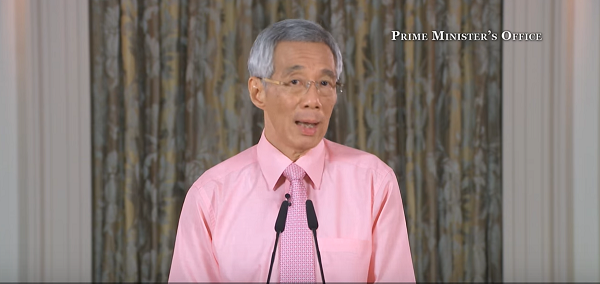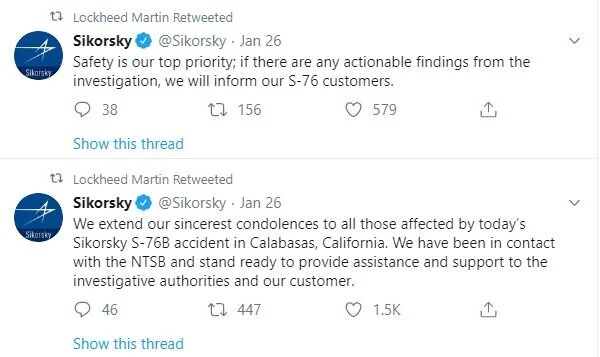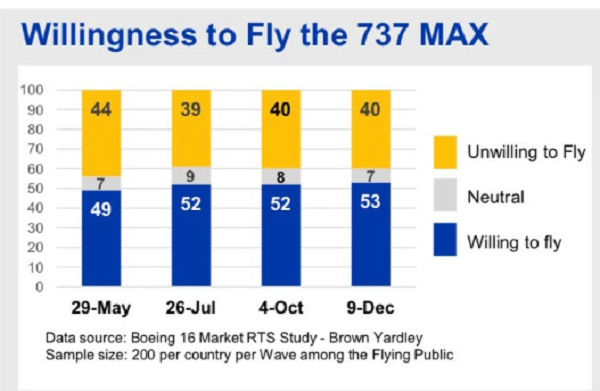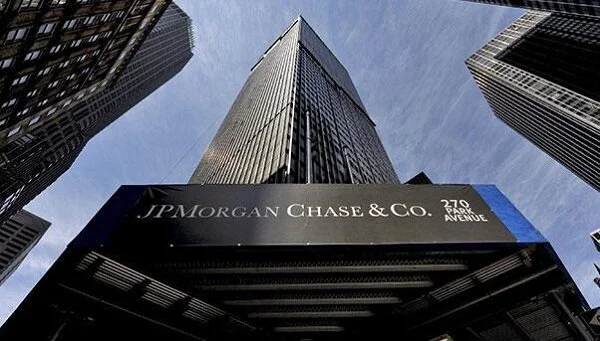Starbucks Communication
The Starbucks website has been updated regularly with news about the company’s response to COVID-19. Near the top of the page is a link to “At-a-glance: What customers need to know about Starbucks response to COVID-19.”
The big news is that stores will offer only drive-thru service for the next two weeks. In a letter to Starbucks partners (employees), the company promised 30 days of pay whether they work or not.
Discussion:
Analyze both the public website and the letter to partners. Describe the audiences and communication objectives of each.
What organizational structure is used for these bad-news messages?
What does Starbucks do well in its communications? How can communications be improved?
How well does the company balance emotional appeal and logical arguments?
In this post, you see “Starbucks response” on the company’s website and “Starbucks partners” in my text. Neither has an apostrophe. Is that correct?
Singapore PM Lee Hsien Loong
Two students sent me Singapore Prime Minister Lee Hsien Loong’s news conference as a positive example. I can see why: he gives a model speech, balancing emotional appeal and straight talk. He is proud of Singapore’s response, and yet he is honest about the challenges ahead. The PM also gives examples from other countries and the lessons learned.
Discussion:
What are the strengths of the Prime Minister’s speech?
Assess his delivery skills.
How have leaders in other countries followed this example—or how have they fell short?
Which leadership character dimensions does the PM demonstrate in his speech?
Comparing Airlines Messages About COVID-19
Transportation companies would like to see more people travel, yet people are wary of COVID-19. Compare these emails to travelers:
Discussion:
Analyze the messages: audience, communication objectives, organization, writing style, etc.
In what ways are the messages similar and different? How might the travel mode—airline or bus—affect the communication choices?
Which messages are most and least effective and why?
What’s your view of the American Airlines video? How does the media choice affect the message?
Communications About Kobe Bryant
NBA superstar Kobe Bryant, his daughter, and seven others died in a helicopter crash, and many are mourning the loss. At the Emmy’s, celebrities paid tribute to his life, and the NBA postponed a Lakers—Clippers game.
The helicopter company, Sikorsky, owned by Lockheed Martin, posted two tweets and a short statement on its website:
We extend our sincerest condolences to all those affected by the January 26th Sikorsky S-76B accident in Calabasas, California. We have been in contact with the NTSB and stand ready to provide assistance and support to the investigative authorities and our customer. Safety is our top priority; if there are any actionable findings from the investigation, we will inform our S-76 customers.
Discussion:
Analyze the Sikorsky messages. Who are their primary and secondary audiences? What are the communication objectives, and how well did the company achieve them?
Have you seen other communications from Sikorsky? Should the company do or say more? If so, what?
Boeing's Crisis Communication Plan
During the holiday break, several news items about Boeing were relevant to business communication and character. In one article, the New York Times revealed internal Boeing documents showing a company trying to rebuild its image after two MAX crashes within a year..
The documents give us an inside view of how the company plans to use persuasive strategies to win back customers. In one graphic, we see customers’ willingness to fly. In another, we see customer concerns and ways Boeing can address them, for example, with FAQ cards, “pilot confidence videos,” or personal connections (for example, “Flight attendant offers comfort and information on the safety of the MAX”).
Discussion:
What persuasive strategies does the company plan? Try to find examples of logical argument, emotional appeal, and credibility.
What are the consequences of this information becoming public? Does it likely endear the public to the company’s concerns, embarrass the company, or something else?
JPMorgan Recorded Phone Conversation
Jimmy Kennedy, an African-American former National Football League player, tried to open a private wealth account at JPMorgan but had trouble getting attention. He recorded a conversation with an African-American employee, Richardo Peters, who said, “You’re bigger than the average person, period. And you’re also an African-American. We’re in Arizona. I don’t have to tell you about what the demographics are in Arizona. They don’t see people like you a lot.”
In a New York Times article that published the recording, Peters recounted a specific example of discrimination against a Black customer. When he was trying to bring on another new client, who had received a large settlement, his manager said, “You’ve got somebody who’s coming from Section 8, never had a nickel to spend, and now she’s got $400,000, What do you think’s going to happen with that money? It’s gone.” His manager’s position was that the customer would not invest money with the bank.
Other incidents at the bank led to Peters’ termination, and he is suing for racial discrimination. JPMorgan also recently settled a class-action lawsuit for $24 million to Black employees who claimed discrimination: according to a New York Times report, “in some cases by isolating them from colleagues and dumping them in poorer branches.”
A few days later, CEO Jamie Dimon addressed the situation in a memo to employees.
Discussion:
How do you assess this situation at JPMorgan? Read more in the NYT article.
A February Essence article describes and praises JPMorgan’s Advancing Black Pathways program to support the Black community. What’s your view of the effort in light of this news?
How do you assess CEO Jamie Dimon’s response in the memo? We don’t see the entire memo, but CNBC posted quotes.
Letter from WeWork Employees
As WeWork plans layoffs, employees are asking for input into what happens to them and their peers. Referring to themselves as WeWorkers Coalition, the employees wrote a letter to the management team.
To the We Company Management Team:
WeWork’s company values encourage us to be “entrepreneurial, inspired, authentic, tenacious, grateful and together.” Today, we are embracing these qualities wholeheartedly as we band together to ensure the well-being of our peers.
We come from many departments across the company: building maintenance, cleaning, community, design, product, engineering and more. We believe that in the upcoming weeks we have the unique opportunity to demonstrate our true values to the world. This is a company that has inspired many of us, challenged us, and has been a formative personal and professional experience for those of us who began our careers here. WeWork has been not just a workplace, but a source of friendships and inspiration along the way.
We also believe our product can have a lasting positive impact on the world. We want to improve workplace happiness for millions of office workers and support small and medium sized businesses in their entrepreneurial efforts. We have been proud to support these goals and dedicate our time and talent to achieve them. This has been our story so far.
Recently, however, we have watched as layers are peeled back one-by-one to reveal a different story. This story is one of deception, exclusion and selfishness playing out at the company’s highest levels. This is a story that reads as a negation of all our core values. But this story is not over.
Thousands of us will be laid off in the upcoming weeks. But we want our time here to have meant something. We don’t want to be defined by the scandals, the corruption, and the greed exhibited by the company’s leadership. We want to leave behind a legacy that represents the true character and intentions of WeWork employees.
In the immediate term, we want those being laid off to be provided fair and reasonable separation terms commensurate with their contributions, including severance pay, continuation of company-paid health insurance and compensation for lost equity. We are not the Adam Neumanns of this world — we are a diverse work force with rents to pay, households to support and children to raise. Neumann departed with a $1.7 billion severance package including a yearly $46 million “consulting fee” (higher than the total compensation of all but nine public C.E.O.s in the United States in 2018). We are not asking for this level of graft. We are asking to be treated with humanity and dignity so we can continue living life while searching to make a living elsewhere. In consideration of recent news, we will also need clarity around the contracts our cleaning staff will be required to sign in order to keep their jobs, which are being outsourced to a third party. Those of us who have visas through WeWork need assistance and adequate time to find a new employer to sponsor our respective visas.
In the medium term, employees need a seat at the table so the company can address a broader range of issues. We’ve seen what can happen when leadership makes decisions while employees have no voice. We will need to see more transparency and more accountability.
We also need the thousands who maintain our buildings and directly service members to receive full benefits and fair pay, rather than earning just above minimum wage.
We need allegations of sexual misconduct and harassment to be taken seriously, acted on immediately and resolved with transparency.
We need diversity and inclusion efforts to materialize into real actions, not just talking points at company meetings.
We need salary transparency so we can surface and address systemic inequalities.
We need an end to forced arbitration contracts, which strip employees of their right to pursue fair legal action against the company.
We need all of this, and more.
In the long term, we want the employees who remain at WeWork, and those who join in the future, to inherit something positive we left behind. We want them to never find themselves in this position again, and for that to happen, they need a voice.
With this letter we are introducing ourselves, the WeWorkers Coalition. We are taking full advantage of our legal right to establish this coalition, and in doing so, we hope to give the future employees of WeWork the voice we never had.
We want to work with you. Please join us in writing a better ending to this chapter of the WeWork story.
By this Thursday at 5:00 p.m. EST, we would like to receive confirmation of your receipt of this letter and an indication of your willingness to meet us.
The WeWorkers Coalition
@weworkersco • info@weworkersco.org • #weworkers-coalition
Discussion:
What principles of business writing do the employees follow?
What persuasive strategies do they use in the letter? Find examples of logical argument, emotional appeal, and credibility.
What do you consider the strongest and weakest arguments?
What leadership character dimensions are illustrated in this situation?
Boeing CEO Responds to Questions
This week, Boeing CEO Dennis Muilenburg answered lawmakers’ questions about the two Max 737 plane crashes in the past year. Facing families of deceased passengers, Muilenburg began his testimony with an apology:
“I’d like to begin by expressing my deepest sympathies to the families and loved ones of those who were lost in the Lion Air Flight 610 and Ethiopian Airlines Flight 302 accidents, including those who are here in the room today. I wanted to let you know, on behalf of myself and all of the men and women of Boeing, how deeply sorry I am. As we observe today the solemn anniversary of the loss of Lion Air Flight 610, please know that we carry the memory of these accidents, and of your loved ones, with us every day. They will never be forgotten, and these tragedies will continue to drive us to do everything we can to make our airplanes and our industry safer.”
One of the most tense moments was when Senator Ted Cruz questioned Muilenburg (see video). Muilenburg also faced criticism as he was leaving. The mother of a victim of the second crash responded to his invoking his Iowa farm background:
“Go back to Iowa. Do that.” She also said, “I don't feel like you understand. It's come to the point where you're not the person anymore to solve the situation."
Discussion:
Watch more of Muilenburg’s testimony. What are some examples of questions he addressed well, and how could he have done better?
How well does Muilenburg balance emotional appeals, logical arguments, and credibility in his testimony?
What leadership character dimensions are illustrated by this situation and by Muilenburg’s testimony?
Muilenburg’s interaction with the mother is a difficult situation for anyone to handle, and we can certainly understand her grief and anger. How would you have responded?
CNN reports:
“In response, Muilenburg said he respects her viewpoint. "But I want to tell you the way I was brought up. And I'm just being honest here about it. I learned from my father in Iowa ... when things happen on your watch you have to own them and you have to take responsibility for fixing them," he said.
Forever 21 Files for Bankruptcy
Retailer Forever 21 has filed for bankruptcy, and employees are not happy. In its Letter to Customers, posted on the website, the company explains the process:
This does NOT mean that we are going out of business – on the contrary, filing for bankruptcy protection is a deliberate and decisive step to put us on a successful track for the future.
Hundreds of employees are planning to unionize with United for Respect, which also represented employees from Sears and Toys R Us during their bankruptcies.
The Washington Post reports employees’ reactions to the Forever 21 decision:
[S]everal employees cited past instances where Forever 21 swiftly closed stores with little warning or explanation, which prompted their concerns over how the company would treat employees amid bankruptcy.
Unions are seeing opportunities in retail employees. Private-section union membership has been shrinking in the U.S. and is now only 6.4%, compared to 33.9% of government workers. As retail employees get discouraged by their employers, union organizing activity has been increasing.
Discussion:
Analyze the Letter to Customers. Which principles of communicating bad news are followed? How could the message be improved?
Explain the ethics of a company filing for bankruptcy. Use an ethical decision-model, such as that in Chapter 1, to determine the effects.
What’s your view of retail employees unionizing? What are the benefits to employees and potential downsides of union activity and of forming a union?
CEOs Advocate for Gun Safety
CEOs are encouraging senators to pass stricter gun regulations, such as background checks and a “Red Flag” law that allows guns to be taken from someone who poses a threat. The leaders of 145 companies sent a letter asking for the following:
“That’s why we urge the Senate to stand with the American public and take action on gun safety by passing a bill to require background checks on all gun sales and a strong Red Flag law that would allow courts to issue life-saving extreme risk protection orders.”
The Trump Administration has implemented a ban on bump stock devices, which allows a shooter to fire in more rapid succession, and President Trump has supported more thorough background checks for gun buyers.
Discussion:
What’s your view of CEOs taking on this activist role? What is driving them, and what are the potential risks?
What observations do you have about the companies that are represented—and perhaps about those that are not?
Analyze the letter by considering the audience, communication objectives, organization, writing style, and so on. What works well, and what could be improved?
United Air Kerfuffle
A United Airlines representative participated in an entertaining Twitter exchange about seat prices. The customer has a point: it’s silly to have empty seats on a plane. But United also has a point: the seats are more expensive, and this customer didn’t pay the extra fee.
The Lexus analogy is a curious one. The better analogy may be stadiums or theaters. In some cases, we will see people move closer to a field or a stage, but I understand (although I’ve never been) that this isn’t allowed at the U.S. Open.
Discussion:
What’s your view of United Airlines’ policy? What other examples are similar? Can you think of a better analogy?
What’s your view of the Twitter exchange? Is the customer right, antagonistic, rude, or something else? How about the United rep?
Dorian News Conferences
Local officials are holding news conferences about the impact of Hurricane Dorian.
Miami Mayor Francis Suarez announced mostly good news for the city, but he also addresses the terrible impact on the Bahamas.
Bahamas Prime Minister Hubert Minnis announced worse news: five fatalities. Since then, the number has risen to 30.
Discussion:
Compare these two presentations, particularly the content and tone. What differences do you notice?
How effectively did each government official convey the news?
What leadership character dimensions did they demonstrate?
Employees Pressure Walmart to Consider Role in Gun Violence
Walmart is in a tough spot after recent shootings. Some employees are pressing the company to do more to fight gun violence, but no policy changes are planned. After previous attacks, Walmart stopped selling assault-style weapons and raised the minimum age to purchase guns and ammunition, but it’s unclear whether the leaders will do more. Employees are asking Walmart to stop selling firearms and to disallow customers from carrying guns into the stores.
The company seems divided about employees’ activism. Chief Executive Doug McMillon wrote, ”We are proud to be woven into the American fabric as a place for all people. We are more resolved than ever to foster an inclusive environment where all people are valued and welcomed.” At the same time, the company blocked two employees’ access to Slack, encouraging employees to use “more constructive ways for associates to offer feedback such as emails or conversations with leaders.”
A study recently published in the International Journal of Business Communication found that employees are more likely to “express dissent to managers and coworkers” when they are more socialized in the company and when they believe their company is “more ethical and reputable.”
A Wall Street Journal article explains the risk for Walmart to take more action against gun sales:
“[A]ny change to its gun policies risks alienating Walmart’s core customers, who often live in more conservative-leaning rural and suburban communities. The company faced some consumer backlash after raising the minimum age to purchase guns to 21.”
Discussion:
How can the company balance employees’ and customers’ perspectives? What else, if anything, should company leaders say and do?
Did the company do the right thing by blocking Slack access? In what ways are email and conversations more or less “constructive”?
What leadership character dimensions are illustrated by this situation?
How to Deal with Being "Ghosted"
Too often, employers stop responding to candidates. Even after an in-person interview, candidates never hear back. The CEO of a job search platform advises people to follow up in a few ways:
Send one email a week. Be thoughtful about your messages to express interest; maybe share new research about the company .
Try different channels. For example, send a LinkedIn message instead of email, but only once.
Reach out to others. Contact another recruiter or the hiring manager directly.
All of these actions come with risk, but the writer argues, and I agree, that the risk is worth it. None of these follow-ups are too annoying, and you may turn the tide in your favor.
Discussion:
Why do you think employers ghost applicants? Consider what incentive they have to follow up.
What’s your view of these follow-up approaches? Which are you more or less comfortable doing?
Suicide Among France Télécom Employees
Management couldn’t fire employees at France Télécom, so, according to critics, they harassed them hoping they would quit. But at least 35 committed suicide under the pressure, and some reports claim the number is closer to 60.
France Télécom was privatized and rebranded as Orange in July 2013. The company wasn’t keeping up with technological changes and, according to executives, were saddled with state employees, who are protected from termination. In 2007, Didier Lombard, the former chief executive of France Télécom, said they would get to their ideal number of layoffs “one way or another, by the window or by the door.”
A New York Times article describes the environment: “A grim universe of underemployment, marginalization, miscasting and systematic harassment was established at the huge company, according to testimony at the trial.” Managers tried changing job responsibilities for some workers, but employees were left without tasks or with tasks they couldn’t do.
With France’s high unemployment rate, employees felt they had few options. Union members, shown here, express their support during the trial in Paris. We’ll see whether the judges find company executives guilty.
Discussion:
How did management justify its practices? On the other hand, how could they have acted differently?
What experience do you have with international labor laws? Describe differences and how they might affect business decisions.
Should France reconsider its lifetime employment protections?
What leadership character dimensions are illustrated by this situation?
Restaurant Owner Forgives Manager for $4,710 Mistake
The manager of Hawksmoor Manchester steakhouse accidentally served a $5,000 bottle of wine when the guests ordered one priced at $290. The owner forgave her publicly, on Twitter.
Naturally, the conversation doesn’t end there. Jokes abound, one announcing that the manager has since been placed in an “on-site incinerator.”
Others pounced on the expensive wine and criticized the restaurant, to which the owner responded in a tweet:
I’m sure you’re all getting tired of this now, so one last thing, to the people who put homelessness in Manchester next to ‘£4500 wine?!’ and suggesting we have no values: we’ve raised well over £1m for @ACF_UK, work with @WoodSt_Mission and @notjustsoupMCR. We have values.
Discussion:
What leadership character dimensions are demonstrated by this story?
How well did the owner respond to criticism?
Leadership Challenge at Uber
A New York Times article describes discomfort among Uber’s leadership as the company plans to go public. Founder and former CEO Travis Kalanick wanted to join the company to ring the opening bell at the New York Stock Exchange, a tradition for IPOs. Kalanick still holds a seat on the board and, as founder, he wanted to participate in the company’s joyous moment—and to bring his father.
Current CEO Dara Khosrowshahi denied the request. For two years, Khosrowshahi has been trying to shed negative public perceptions of Uber, partly attributed to Kalanick’s leadership style and the company’s “bro-culture.”
The article describes a fractured board that didn’t fully support Khosrowshahi and a company that has yet to turn a profit, losing revenue on almost every car ride. Uber follows Lyft’s recent IPO, which has lost about $26 per share since its IPO in March.
Discussion:
Did Khosrowshahi make the right decision? Why or why not?
Consider Kalanick’s perspective. What’s his point of view? Should he have asked at all?
What leadership character dimensions are illustrated by this situation?
Boeing's Crisis Response
At a shareholder’s meeting, Boeing CEO Dennis Muilenburg addressed 737 Max safety concerns following two fatal crashes. He started, as predicted, with an apology and sympathy for the “loss of life,” acknowledging the “devastation.” He contrasted these losses with the many Boeing flights that run safely—”roughly every 1.5 seconds.”
Muilenburg didn’t explicitly address issues raised in the past couple of days, particularly a Wall Street Journal article the previous day accusing Boeing of failing to report the safety feature shut-off to airlines (including pilots) and the FAA.
When asked during the Q&A about accountability, Muilenburg spoke mostly about plans going forward. When asked whether he would resign, he talked about his and his employees’ commitment to safety.
At about 9:00 on the video, a reporter asks about whistle-blowers at Boeing, referring to recent reports that employees tried to alert senior management and the Federal Aviation Administration (FAA). Muilenburg says the question is “fair” but doesn’t quite respond to the accountability issue. At about 14:15, a reporter asks, “Can you admit that the design was flawed?” This is after Muilenburg skirts the previous question, blaming a “chain of events.” Still, he would not admit to a design flaw.
And then he ends the news conference, as a reporter shouts, “Sir, 346 died. Can you answer a few questions here about that?” Earlier, another reporter noted that this was the first time they had a chance to meet with him to ask questions.
Discussion:
Assess Muilenburg’s delivery skills. What does he do well, and what suggestions would you have for his future news conferences?
How well did Muilenburg address reporters’ questions? What, if anything, could he have said differently?
What leadership character dimensions are illustrated by this story? How well did Muilenburg demonstrate them?
New Zealand Announces Weapons Ban
Following a shooting at a mosque in Christchurch that left 50 people dead, New Zealand Prime Minister Jacinda Ardern announced a ban on certain types of weapons:
“Today, I’m announcing New Zealand will ban all military-style semiautomatic weapons. We will also ban all assault rifles. We will ban all high-capacity magazines. We will ban all parts with the ability to convert semiautomatic or any other type of firearm into a military-style semiautomatic weapon. We will ban parts that cause a firearm to generate semiautomatic, automatic or close-to-automatic gunfire,” she added. “In short, every semiautomatic weapon used in the terror attack on Friday will be banned in this country.”
She said the decision would accomplish one goal: “to prevent an act of terror from happening in our country ever again.” In a press conference three days prior, the prime minister had promised that the Cabinet planned to take action.
The New York Times compares the process for buying a gun in 16 countries, showing the United States as having the fewest steps.
Discussion:
What’s your view of the decision and how Prime Minister Arden communicated it to the public?
What leadership character dimensions does the Prime Minister demonstrate in this situation?
Watch Prime Minister Arden’s press conference and one or two others. How would you describe her delivery style?
HBO CEO Departs
HBO CEO Richard Plepler is leaving the company. His announcement came shortly after HBO’s chair of the board spoke with the WarnerMedia CEO about possibly taking over HBO and Turner.
Here is Plepler’s email to employees:
My dad always gave the best advice. Whenever there was a difficult decision to make, he counseled that since no one could ever have perfect visibility into the future, the best thing you could do was trust your instincts. It has been a touchstone for me throughout my life, and I have found myself returning to it again recently as I think about what is an inflection point in the life of this wonderful company. Hard as it is to think about leaving the company I love, and the people I love in it, it is the right time for me to do so.
In the past weeks, I’ve thought a lot about the incredible journey of this company in the nearly 28 years that I have been blessed to be here. It’s a journey of great pride and accomplishment because so many of you, and many others before us, have made HBO a cultural and business phenomenon. Thanks to all of you, we are today churning on all cylinders both creatively and as a business. Thanks to all of you, I can move on to the next chapter of my life knowing that the best team in the industry remains here to carry on our continued progress and success. As I have said before, this is the team of teams.
It has been the great joy of my professional life to share this ride with you over these many years. And the great honor of my professional life to be your CEO. I don’t have the words to express my gratitude for the support and talent that made our success together possible. But suffice it to say, my love for this place, and for all of you, is deeply a part of me and will last a lifetime. I look forward over the coming weeks to thanking as many of you as I can for the thousands of contributions big and small that have made “this thing of ours,” to quote Tony Soprano, so special. I have told John, who has been nothing but gracious since we spoke, that I would work closely with him to assure a seamless and organic transition.
We’ve created a great and unique enterprise and I know that you will protect its legacy and do all to enhance its future in the years to come.
Know that I will always be cheering loudly, even when I am outside this building, as HBO continues to thrive.
With respect, admiration, and gratitude,
Richard
Discussion:
Assess Plepler’s email. Who are his primary and secondary audiences? What are his communication objectives?
What principles of business communication does Plepler follow, and how could he improve the email?
What, if anything, does he give as the reason for his decision? Should he say more about this? Why or why not?
What leadership character dimensions are illustrated by his email?

































